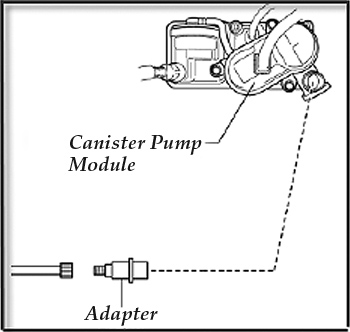Applicability: All Toyota vehicles with key off EVAP system.
Condition:
• MIL On with DTC P0456 or P0455 and P0441
• MIL On with DTC P043E, P043F, P2401, P2402, P2419
Service Recommendations:
1. Clear any DTCs and run the automatic EVAP system check.
2. Check for pending DTCs.
a. DTCs P0456 or P0455 and P0441 set – refer to inspection procedure A.
b. DTCs P043E, P043F, P2401, P2402 and P2419 set – refer to inspection procedure B.
Inspection Procedure A – DTCs P0456 or P0455 & P0441
1. Visually inspect the fuel cap and all EVAP lines/connections for leaks.
2. Disconnect the fuel tank vent hose (between the fuel tank and the canister) from the charcoal canister.
3. Seal off the fuel tank vent hose connection at the charcoal canister to isolate the canister side.
4. Clear any DTCs and run the auto EVAP system test again.
a. If DTCs P0456 or P0455 and P0441 appear in pending, the leak is on the canister side.
b. If the system passes with no pending DTCs, the leak is on the tank side.
Note: The canister side consists of the charcoal canister, purge line and purge VSV. The tank side consists of the fuel tank, gas cap and filler neck.
5. Pressurize the EVAP system through the fresh air vent line using the EVAP Tester & SST Adapter. See Fig. 1. Check for leaks on the tank or canister side as needed.
Inspection Procedure B – DTCs P043E, P043F, P2401, P2402 and P2419
1. Perform an active test using Techstream (Vacuum Pump).
2. Measure the voltage of the leak detection pump wires with the vacuum pump active test on. Refer to the appropriate repair manual for the voltage specification.
Note: Back-probe the leak detection pump motor with the electrical connector connected. Wire colors and pin numbers for the leak detection pump may vary by vehicle.
3. If voltage is not present, diagnose the electrical circuit failure. Proceed to the next step if battery voltage is present.
4. Remove the EVAP lines connected to the charcoal canister and inspect for liquid intrusion.
5. Replace the charcoal canister assembly with a vacuum pump if liquid intrusion has occurred.
Note: For vehicles equipped with a separate vacuum pump and canister, replace only the vacuum pump. Canister replacement is necessary only if liquid intrusion has occurred.
6. Clear any DTCs and run the auto EVAP test again to confirm the repair.
Courtesy of Toyota Motor Sales.













